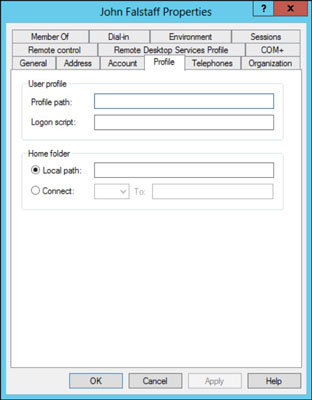For each user account you create on your network, you can set additional properties for the user by right-clicking the new user and choosing Properties from the contextual menu. This command brings up the User Properties dialog box, which has about a million tabs that you can use to set various properties for the user.
(A user profile is a collection of settings for a user account. It is stored in the user's C:\Users\
From the Profile tab, you can configure three bits of information about the user's profile information:

• Profile Path: This field specifies the location of the user's roaming profile.
• Logon Script: This field is the name of the user's logon script. A logon script is a batch file that's run whenever the user logs on. The main purpose of the logon script is to map the network shares that the user requires access to.
Logon scripts are carryovers from early versions of Windows NT Server. In Windows Server 2012, profiles are the preferred way to configure the user's computer when the user logs on, including setting up network shares. Many administrators still like the simplicity of logon scripts, however.
• Home Folder: This section is where you specify the default storage location for the user.
This is a excerpt from Networking For Dummies, 10th Edition
Both beginning network administrators and home users have made previous editions of this book a top seller. Now fully updated, this edition shows you step by step how to set up and maintain a network and covers Windows 8 and Windows Server 2008 R2 SP1. Author Doug Lowe also includes updated coverage of broadband technologies as well as storage and back-up procedures, all in his easy-to-follow style. You'll learn to build a wired or wireless network, secure and optimize it, safely connect to the Internet, troubleshoot problems, and much more.
• A perennial bestseller, this guide to networking has been fully revised
to cover new broadband technologies, and updated storage and backup procedures
• Provides introductory-level networking fundamentals for those inexperienced in network technology
• Covers networking with all major operating systems
• Shows
how to build, secure, and optimize a network, safely connect to the Internet, troubleshoot problems, and more
Networking For Dummies, 10th Edition walks you through the process of setting up and maintaining a network, at home or in the office.
Reader Glen Hollander says,"I picked this up for additional information after taking a work related class tied in to networking. This did help to clarify some points. It was an aid for the class." For more information Click here.
More Windows Administration Information:
• WSH to Master Your Computer
• Introduction to Windows PowerShell
• How to Block Unwanted Websites with Your Netgear Router
• Installing a Local Printer on Windows Vista
• Windows PC Performance Troubleshooting and Optimisation
• What is Hyper-V in Windows Server 2019?
• The Windows 7 Backup and Restore Utility
• How to Change Process Priorities in Windows Task Manager
• Command Line to Get Computer's Numner of CPU Cores
• Configure Vista's Data Execution Prevention


